
British postcard in the Picturegoer Series, London, no. 864. Photo: Metro-Goldwyn-Mayer. Johnny Weissmuller in Tarzan and his Mate (W. S. Van Dyke, 1934).

Spanish postcard by JDP, Barcelona, no. 1475. Lex Barker in Tarzan’s magic fountain (1949).

Italian Real Photo postcard, no. 401. Gordon Scott as Tarzan
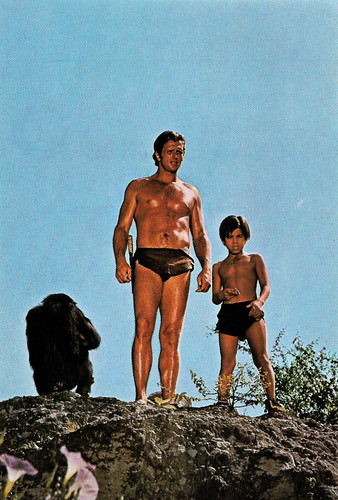
German collectors card by Penny in the series 'Unsere Bambi-Lieblinge', no. 27. Ron Ely as Tarzan and Manuel Padilla Jr. as Jai with Cheeta in the TV series Tarzan (1966-1968).

French double card. Image: Burroughs / Disney. An animated Tarzan in Tarzan (Chris Buck, Kevin Lima, 1999).
White skin
American writer Edgar Rice Burroughs (1875-1950) published 'A Princess of Mars' under the title 'Under the Moons of Mars' in six parts between February and July of 1912. The same All-Story Magazine put out his immediately successful 'Tarzan of the Apes' in October of that year. Two years later the hardback book appeared.
Tarzan is the orphaned son of aristocratic English parents, John and Alice Clayton, or Lord and Lady Greystoke, who are stranded on the west coast of Africa in the late 19th century after a mutiny aboard the ship taking them to Africa. They try to survive in the coastal jungle.
When his parents die, the human baby is adopted and raised by the ape Kala, who has just lost her own young. Tarzan's real name is John Clayton, Lord Greystoke, but Tarzan ('white skin') is the new name given to him by Kala. The only people Tarzan comes into contact with during the first 18 years of his life are members of a cannibal tribe. One of them, Kulonga, kills Tarzan's nurse Kala, after which Tarzan takes bloody revenge.
Years later, Tarzan finds some children's books in his real parents' cabin. Using the pictures and letters, he teaches himself to read and write, but a human language he does not learn until much later - when he is discovered by white people.
The first people he meets are young American Jane Porter, her father and French lieutenant commander Paul D'Arnot. From the latter, he learns to speak the first human language, which is French, and later English. D'Arnot will also remain Tarzan's best friend for the rest of his life, taking him into the civilised world. The Porters, along with another group of people, are left behind in Africa by mutineers. Tarzan and Jane meet and instantly fall in love. When Jane returns to America, Tarzan eventually goes after her. In later books, the two are married and have a son named Jack, whose name in the monkey language is Korak ('the slayer').
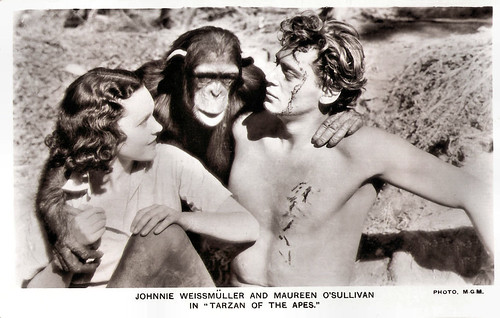
British postcard in the Picturegoer Series, no. 680. Photo: M.G.M. Publicity still for Tarzan the Ape Man (W. S. Van Dyke, 1932) with Johnny Weissmuller and Maureen O'Sullivan.

British postcard by Real Photograph, London, no. FS 208. Photo: Metro-Goldwyn-Mayer (MGM). Johnny Weissmuller and Maureen O'Sullivan in Tarzan Finds A Son (Richard Thorpe, 1939).

Vintage postcard. Johnny Weissmuller.

British postcard in the Picturegoer series, London, no. W 370. Photo: Metro-Goldwyn-Mayer.

Dutch postcard, no. 751. Photo: M.G.M.
Eternal youth
'Tarzan of the Apes' was a great success, but Edgar Rice Burroughs's later books were often less well-received. A common criticism was that the books maintained too much of a fixed formula that was repeated over and over again. However, Tarzan is one of the world's best-known fictional characters. Apart from almost 30 books by Burroughs and some by other authors, he also appears in many films, television series, comic book series and radio plays. Although the copyright on the original Tarzan story has now expired in the United States, the Tarzan name is still copyrighted. The rights are held by Edgar Rice Burroughs, Inc.
Tarzan, in the original books by Burroughs, is a hero with mostly good qualities. He is a tall, very athletically built white man, with grey eyes and black hair. He is highly intelligent and learns a new language easily and quickly. Some elements in the Tarzan stories and films were racist. Burroughs was a child of his time. For instance, the African indigenous people featured in the stories are regularly portrayed in a stereotypical and negative way. On the other hand, the tribe of Waziri, whom Tarzan takes in when he helps them in their fight against Arab slave traders, are described by Burroughs as wonderful people. They play a significant role in several Tarzan novels.
Tarzan's upbringing among the great apes and his years living in the jungle gave him skills beyond those of most people. He has extra-sharp senses. For instance, he can hear an enemy approaching from miles away or smell danger. He usually wears only a loincloth. Preferably, he moves around by swinging and jumping from branch to branch in the high tree terraces. He rarely if ever uses lianas, although they are more often seen in films. Tarzan, through the use of special pills obtained through a mysterious Kavuru tribe and treatment by a black witch doctor, has 'eternal youth'.
In the last Tarzan book completed by Burroughs, set at the end of World War II, he looks like a man in his late twenties. In reality, however, he is by then close to 60. His wife Jane and his faithful monkey Nkima were also taking those pills regularly. Tarzan's love for his wife Jane is unconditional, and he regularly rejects advances by other women, even when they are more beautiful and interesting than Jane; in Edgar Rice Burroughs' novels, for instance, Queen Nemone and High Priestess La of the Lost City of Opar.
In battles with wild animals, he always emerges victorious. Of all the animals in the jungle, contrary to what non-experts think, Tarzan can only communicate with monkeys, although he also has a special bond with elephants, who somehow seem to understand him to some extent. Elephants also come to his rescue when he calls them to his aid in emergencies. In various film versions, Tarzan has intelligent animals as friends. The chimpanzee Cheetah is the best-known example. However, Cheetah does not appear in Burroughs' original books. Indeed, no chimpanzees appear in the books at all. Tarzan's constant companion, the very small monkey Nkima, is a troublemaker with a bloodthirsty nature, but very helpful in emergencies.
A large monkey species unknown to humans, grey in hair colour, called the 'Mangani' in the books, is the one in which Tarzan grew up and of which he later became 'king'. The gorillas ('Bolgani') are the mortal enemies of that tribe of apes, and thus also of Tarzan. With elephants, Tarzan has a special and strong bond. He calls this species 'Tantor' (that is, not the name of one specific elephant). Jad-Bal-Ja, the 'golden lion', is a giant lion with a black mane, trained by Tarzan who found the animal as a cub. Together with him, Tarzan has various adventures.

Big German card by Ross Verlag. Photo: Paramount. Buster Crabbe in Tarzan the Fearless (Robert F. Hill, 1933).

Spanish collectors cards by Exclusiva Ferber y Blay, no. 7 of 15 cromos. Photo: Sol Lesser Productions. Buster Crabbe in Tarzan the Fearless (Robert F. Hill, 1933). The Spanish release title was Tarzan de la las fieras.

French postcard by Editions et Publications Cinematographiques, no. 88. Photo: Metro-Goldwyn-Mayer. Johnny Weissmuller.

Belgian postcard by Les Editions d'Art L.A.B., Bruxelles, no. 2022. Photo: Metro-Goldwyn-Mayer. Maureen O'Sullivan and Johnny Sheffield in Tarzan's Secret Treasure (Richard Thorpe, 1941).
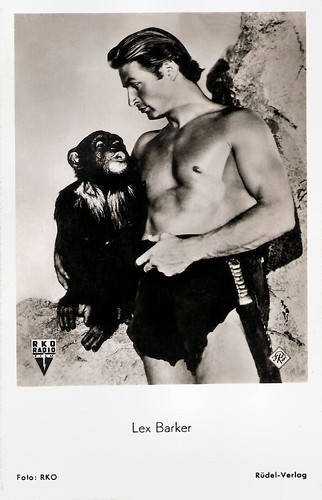
German postcard by Rüdel-Verlag, Hamburg-Bergedorf, no. 449. Photo: Alex Kahle / RKO Radio Film. Lex Barker in Tarzan's Magic Fountain (Lee Sholem, 1949).
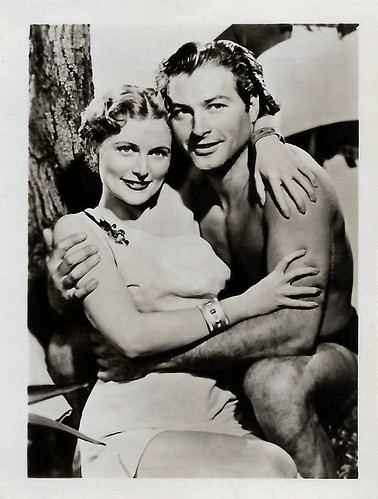
West German collectors card in the Filmstars der Welt series by Greiling-Sammelbilder, series C, no. 103. Photo: RKO. Virginia Huston and Lex Barker in Tarzan’s Peril (Byron Haskin, 1951).
An imposingly built Olympic swimming champion
In 1918, the first Tarzan film was released, the silent feature Tarzan of the Apes (Scott Sidney, 1918). Elmo Lincoln played Tarzan and Gordon Griffith played Tarzan as a child. Stellan Windrow, who initially portrayed the title character in the film, went into military service five weeks after filming began. Lincoln replaced Windrow, although author Edgar Rice Burroughs objected to the choice. It was one of the first films to gross over $1,000,000. Burroughs was able to move his family to the San Fernando Valley in 1919, converting a huge estate into Tarzana Ranch. Elmo Lincoln became famous for the role. He portrayed the character twice more, in The Romance of Tarzan (Wilfred Lucas, 1918) and in the serial The Adventures of Tarzan (Robert F. Hill, Scott Sidney, 1921) with Louise Lorraine as Jane Porter. The serial's prologue features Edgar Rice Burroughs himself.
Tarzan became world-famous, when the imposingly built Olympic swimming champion Johnny Weissmuller played the role of Tarzan, starting with Tarzan the Ape Man (W. S. Van Dyke, 1932) through twelve films until 1948. These films often featured Tarzan's chimpanzee companion Cheeta, his consort Jane (in the first films Maureen O'Sullivan and later Brenda Joyce), and an adopted son, usually known only as Boy (Johnny Sheffield). The most famous statement of the verbally bumbling Tarzan in front of the first human woman he encountered in the guise of Maureen was, "Me Tarzan, you Jane!" However, this is a misconception that has taken on a life of its own after an ill-informed journalist once wrote it down that way. In fact, those words were never spoken that way by Weissmuller. Indeed, in the film scene in question, he points to Jane, and mentions her name, only to point to himself and say "Tarzan". He then repeats the words.
However, the Weissmuller Tarzan version deviated hugely from the original Tarzan, as conceived by writer Burroughs. This was partly due to Burroughs himself, who had a contract with the film company MGM stipulating that no storyline or character from his original books could be used in the films. Only the names Tarzan and Jane could be used, with Jane even being given a surname other than the original one, Parker, instead of Porter. Burroughs would later, after seeing one of Weissmuller's Tarzan films, shake his head, saying "I give them a wonderfully intelligent hero, and they turn it into a country bumpkin".
There were also several serials and features that competed with the main franchise, including Tarzan the Fearless (Robert F. Hill, 1933) starring Buster Crabbe and The New Adventures of Tarzan (Edward Kull, Wilbur F. McGaugh, 1935) starring Olympic champion shot-putter Herman Brix, who would later call himself Bruce Bennett. The latter film serial in 12 chapters was unique for its period in that it was partially filmed on location in Guatemala and portrayed Tarzan as the cultured and well-educated gentleman in the original Edgar Rice Burroughs novels. It was the only Tarzan film project for which Burroughs was personally involved in the production. The New Adventures of Tarzan was later re-released in shorter versions as The New Adventures of Tarzan (1935) and Tarzan and The Green Goddess (1938). To this day, Brix is regarded by Burroughs fans as the most Burroughs-like Tarzan actor ever.
The 1950s saw a major resurgence in Tarzan's popularity. Books and comics were much in demand and Tarzan films and television series followed. Handsome Lex Barker became the new Tarzan in five films for RKO . During the following period, some of the best Tarzan films were made: Tarzan's Greatest Adventure (John Guillermin, 1959) and Tarzan The Magnificent (Robert Day, 1960), both starring the muscular Gordon Scott. These films are considered top of the genre and are much closer to the original than the films starring Weissmuller. The films Tarzan Goes To India (John Guillermin, 1962) and Tarzan's Three Challenges (Robert Day, 1963) with Jock Mahoney as Tarzan, are also brilliant productions in widescreen and colour. Tarzan Goes To India was financially even the most successful Tarzan film ever.
In the 1960s, the quality of the films quickly declined again. Ron Ely did still have a lot of success as the more intelligent Tarzan, in the 57-part television series Tarzan (1966-1968). Tarzan, the Ape Man (John Derek, 1981), starring Miles O'Keeffe and Bo Derek, was filmed from the point of view of Jane Parker. Greystoke: The Legend of Tarzan, Lord of the Apes (Hugh Hudson, 1984) goes back more to Burroughs' story and Tarzan is no longer portrayed as silly as in the Weissmuller films. The next Tarzan film, Tarzan and The Lost City (Carl Schenkel, 1998), with Casper Van Dien, was intended as a sequel to Greystoke, but a too-small budget and an unedifying screenplay made the film flop. Tony Goldwyn voiced Tarzan in Disney's animated film Tarzan (Chris Buck, Kevin Lima, 1999). It was the first major animated motion picture to star the Ape Man and his ape family was portrayed as gorillas in the film. The recent television series Tarzan (2003) with Travis Fimmel in the title role, was not a success either. In Tarzan (David Yates, 2016), Alexander Skarsgård plays the role of a modernised Tarzan. The story follows John Clayton (Tarzan), who, after moving to London, is convinced by George Washington Williams to return to his former home in the jungles of Africa, to investigate claims of slavery.

Vintage postcard. Photo: RKO. Vanessa Brown in Tarzan and the Slave Girl (Lee Sholem, 1950).
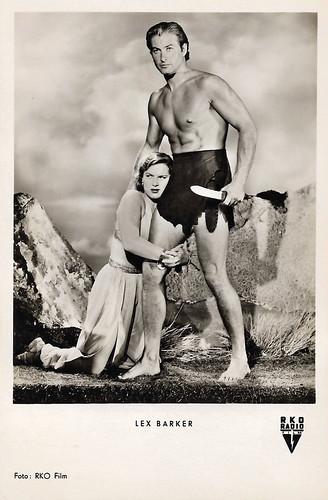
West German postcard by Kunst und Bild, Berlin, no. A 580. Photo: RKO. Lex Barker and Denise Darcel Tarzan And The Slave Girl (Lee Sholem, 1950).

West German postcard by Kunst und Bild, no. I 411. Photo: RKO. Gordon Scott in Tarzan's Hidden Jungle (Harold D. Schuster, 1955).

British postcard by Klasik Kards, no. 1588. Ron Ely in the TV series Tarzan (1966-1968).
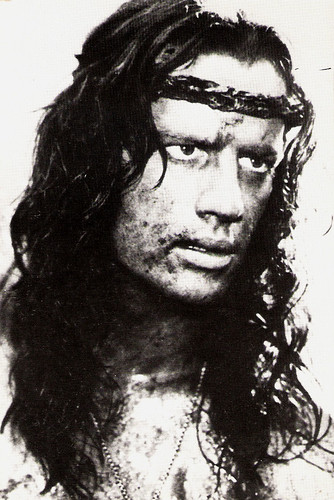
French postcard by Ebullations, no. 60. Christophe Lambert as Tarzan, Lord of the Apes in Greystoke (Hugh Hudson, 1984).

French double card. Image: Burroughs / Disney. Tarzan in Tarzan (Chris Buck, Kevin Lima, 1999).
Sources: Ed Stephan (IMDb), Wikipedia (Dutch and English).
He is the king of the jungle & protector of the wilderness was raised by apes & became man becomes the hero of the jungle & protector of mankind based from the novel by Edgar Rice Burroughs creator of Tarzan stories in popular culture in TV films comics animation & media throughout the world.
ReplyDeleteTarzan anthology series created by Edgar Rice Burroughs.
ReplyDeleteJohnny Weissmuller former American Olympic swimmer and athlete turned film actor portrayed as the king of the jungle and leader of the wilderness in Tarzan film series from the 1930's to the 1940's era Hollywood movies.
ReplyDeleteLex Barker Gordon Scott Jock Mahoney Mike Henry & other actors portrayed as Tarzan lord of the jungle film series.
ReplyDeleteRon Ely former veteran American actor & author portrayed as the king of the jungle in Tarzan aired on NBC Network from the 1960's era based from the novel by Edgar Rice Burroughs creator of Tarzan stories.
ReplyDeleteTarzan & The Brown Prince 1975 action adventure jungle survival superhero melodrama film starring Robin Aristorenas with all star cast filmed entirely in Brazil Spain Mexico & the United States.
ReplyDelete